Thymeleaf讲解
简介
简介:
Thymeleaf 是新一代 Java 模板引擎,与 Velocity、FreeMarker 等传统 Java 模板引擎不同,Thymeleaf 支持 HTML 原型,其文件后缀为“.html”,因此它可以直接被浏览器打开,此时浏览器会忽略未定义的 Thymeleaf 标签属性,展示 thymeleaf 模板的静态页面效果;当通过 Web 应用程序访问时,Thymeleaf 会动态地替换掉静态内容,使页面动态显示。
创建项目
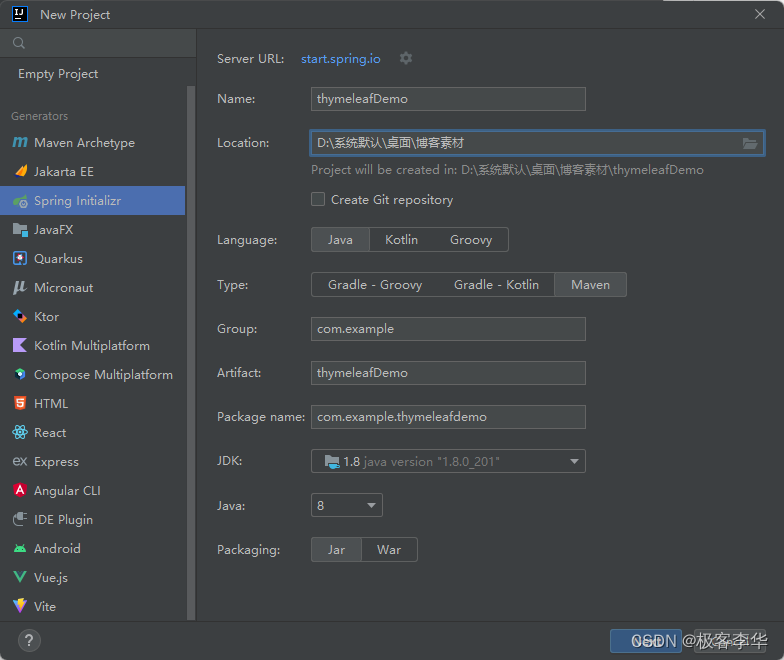
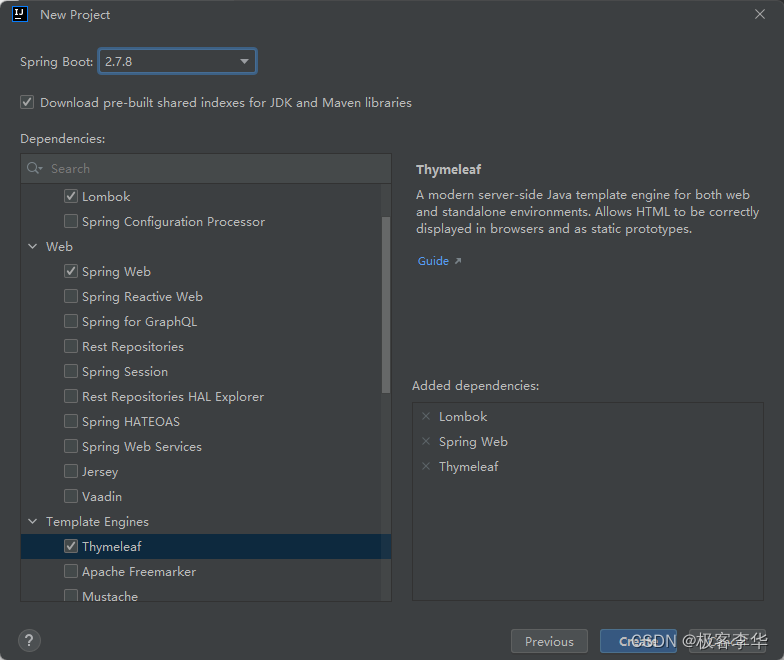
再setting的Editor中的File and code Templates中创建,thymeleaf模板,方便以后的调用。
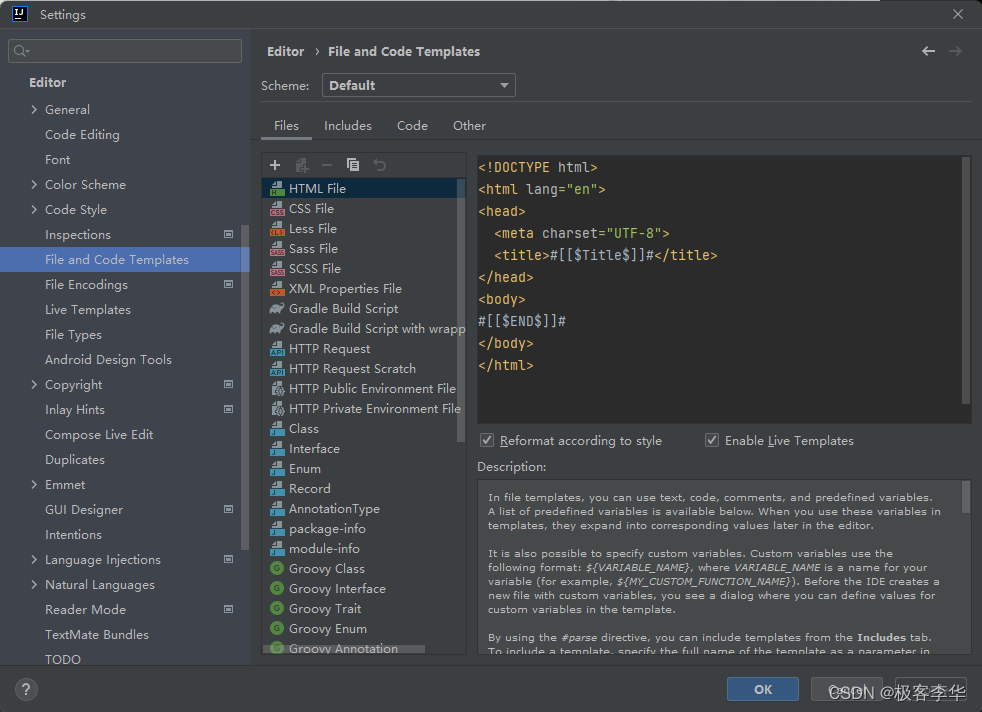
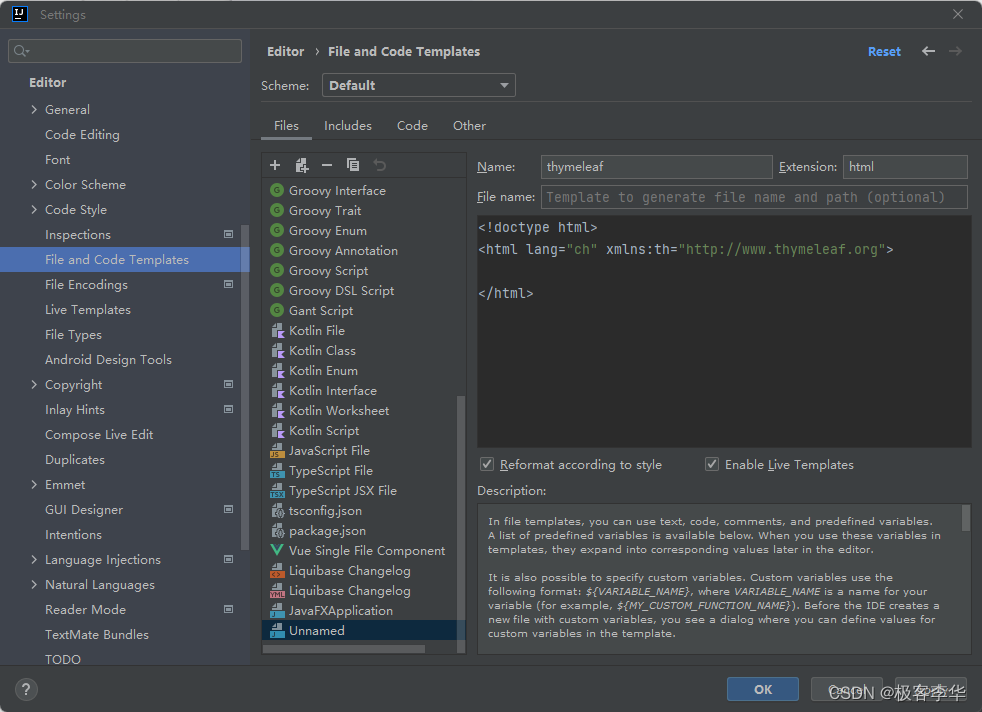
我们再点击新建的时候,就有了这个thymeleaf选项。
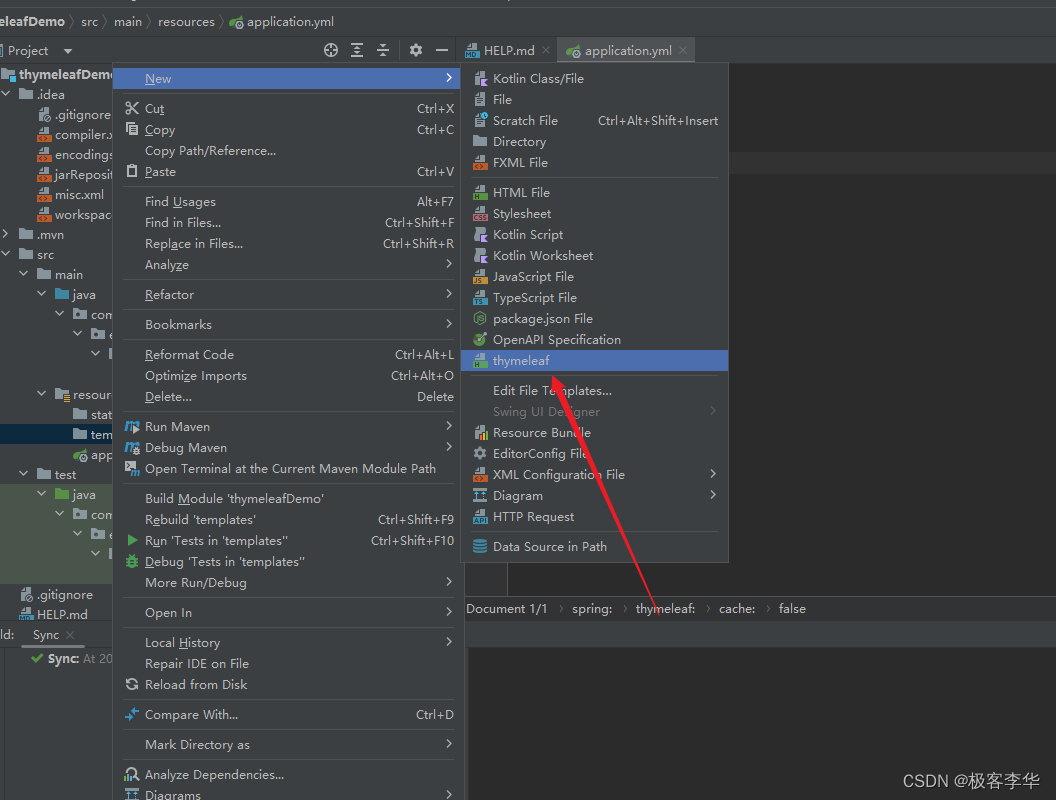
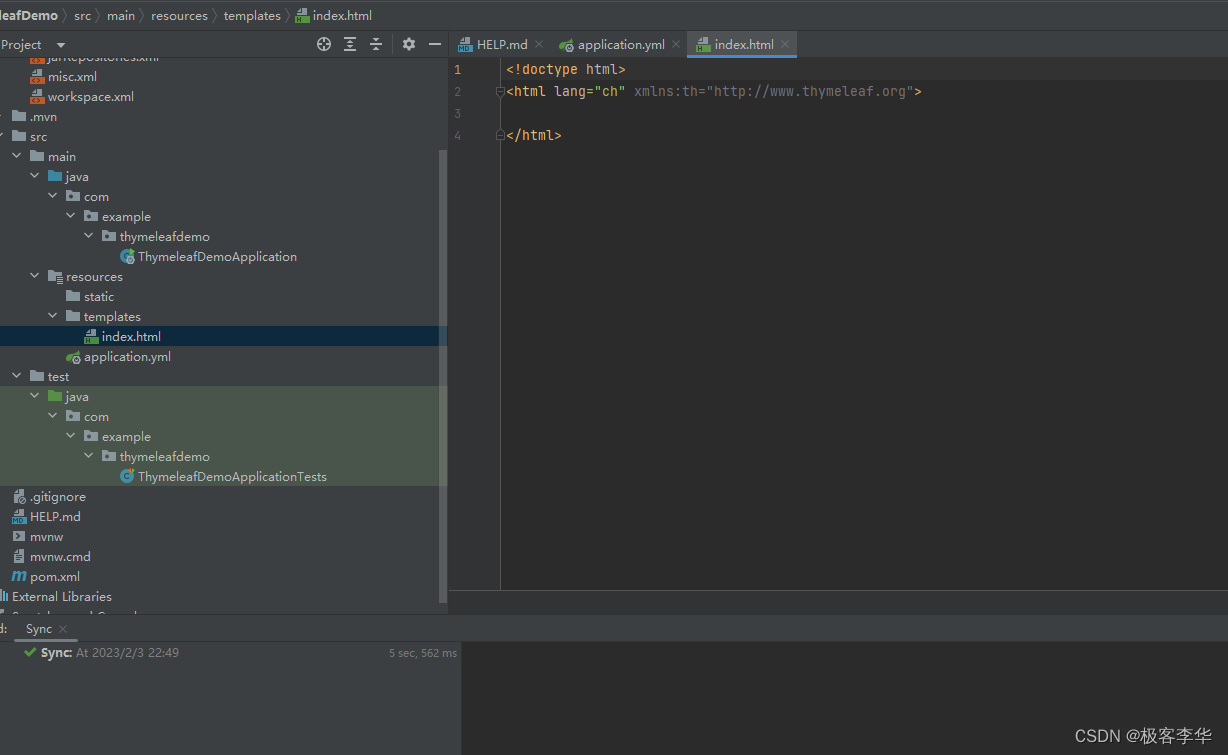
编码
基础使用
代码一(th:text)
第一个语法通过,运行结果进行讲解。
<!doctype html>
<html lang="ch" xmlns:th="http://www.thymeleaf.org">
<head>
<meta charset="UTF-8">
<title th:text="${title}">默认的title</title>
</head>
</html>
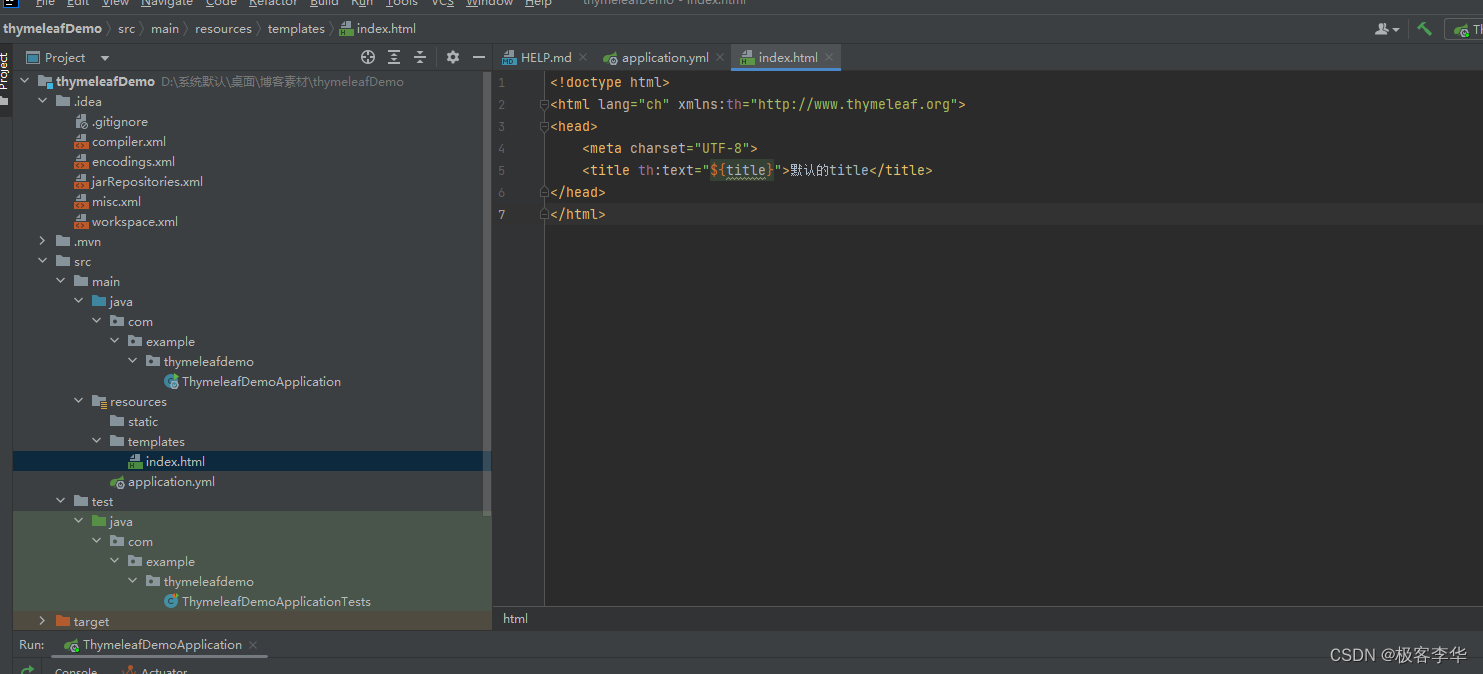
通过运行结果可以看出,当没有后端给前端发送数据的时候,这个前端显示的信息就是规定的默认信息。
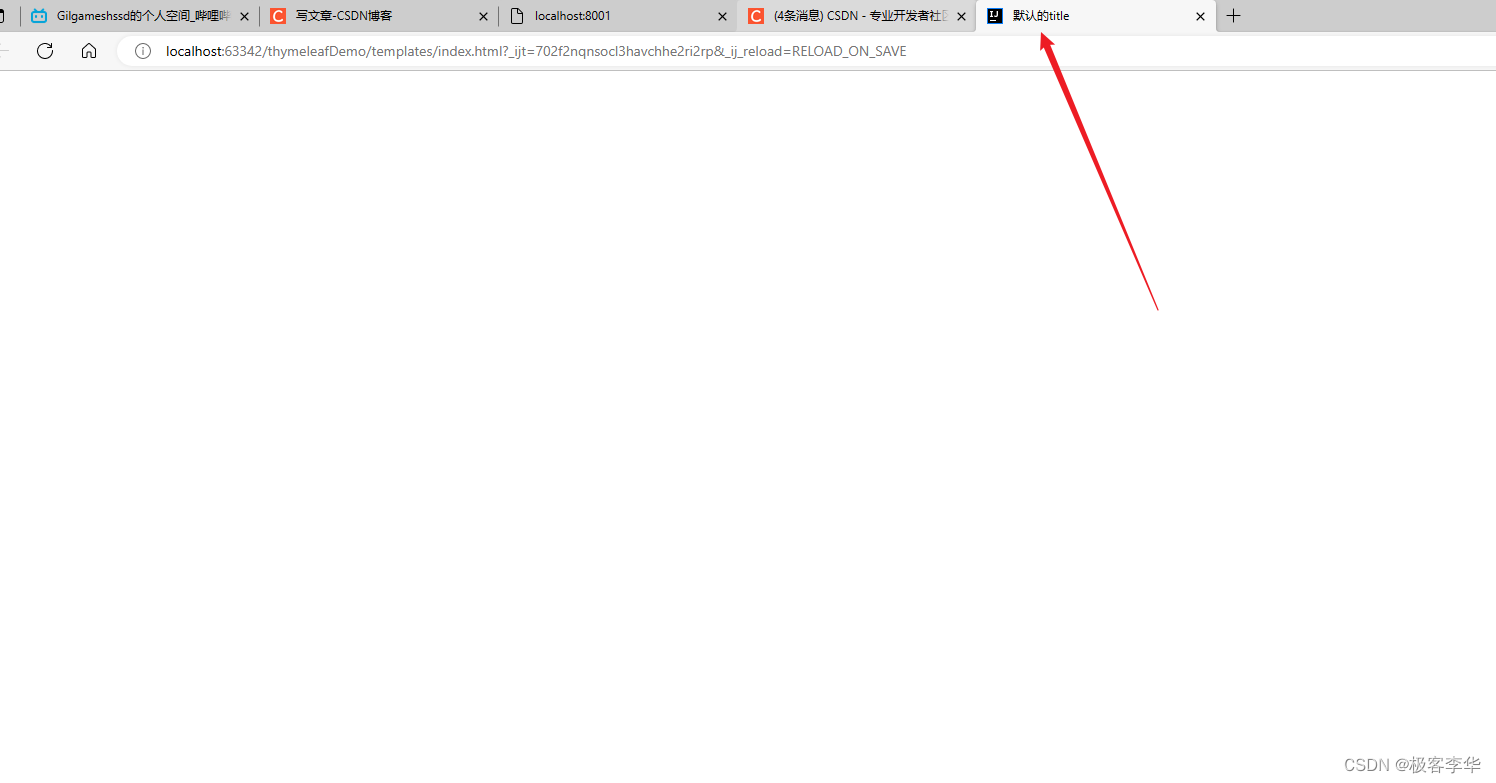
现在加一个后端IndexController
package com.example.thymeleafdemo.controller;
import org.springframework.stereotype.Controller;
import org.springframework.ui.Model;
import org.springframework.web.bind.annotation.GetMapping;
@Controller
public class IndexController {
@GetMapping("/index")
public String index(Model model){
model.addAttribute("title", "传递的Title");
return "index";
}
}
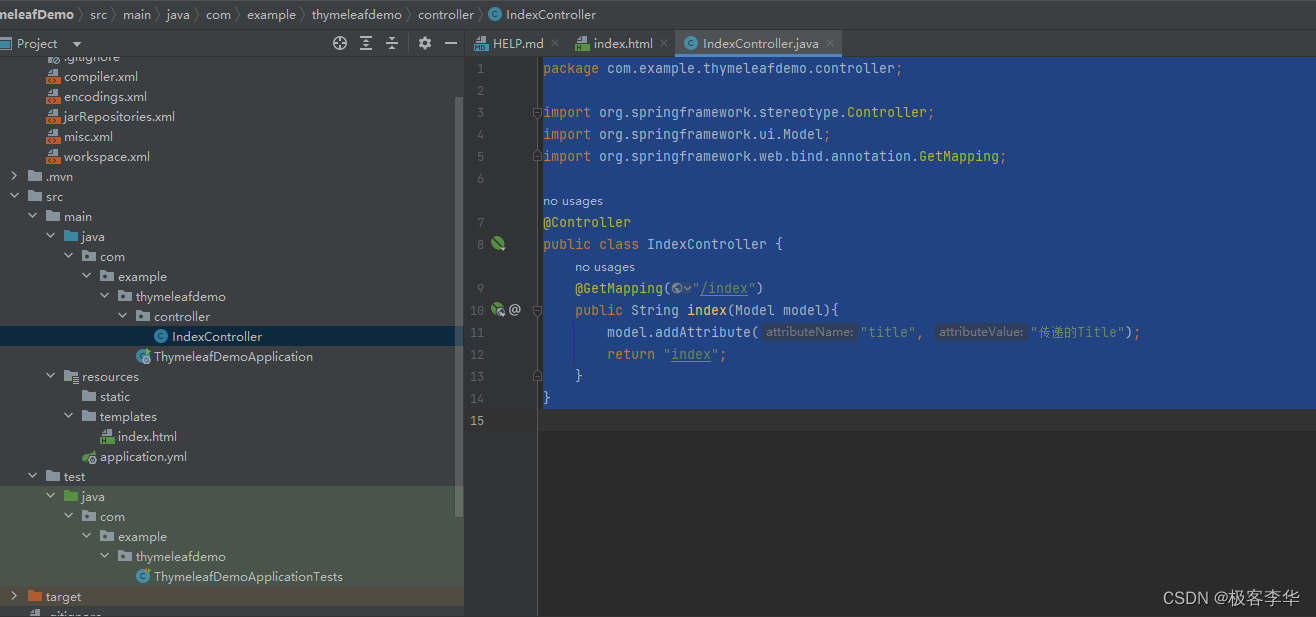
运行结果
通过运行的结果和观察源码,我们都可以发现,这个后端传递给前端的值,在前端生效了。


代码二(th:content)
index.html
<!doctype html>
<html lang="ch" xmlns:th="http://www.thymeleaf.org">
<head>
<meta charset="UTF-8">
<title th:text="${title}">默认的title</title>
<!-- 字符串拼接-->
<meta th:content="|李华的-${description}|" name="description" content="默认的description">
<meta th:content="${keywords}" name="keywords" content="默认的keywords">
</head>
</html>
IndexController
package com.example.thymeleafdemo.controller;
import org.springframework.stereotype.Controller;
import org.springframework.ui.Model;
import org.springframework.web.bind.annotation.GetMapping;
@Controller
public class IndexController {
@GetMapping("/index")
public String index(Model model){
model.addAttribute("title", "传递的Title");
model.addAttribute("description", "传递的description");
model.addAttribute("keywords", "传递的keywords");
return "index"; // 对于html文件可以不写后缀名
}
}
运行结果
通过这个运行结果,我们可以发现,这个content中的内容也更改了。
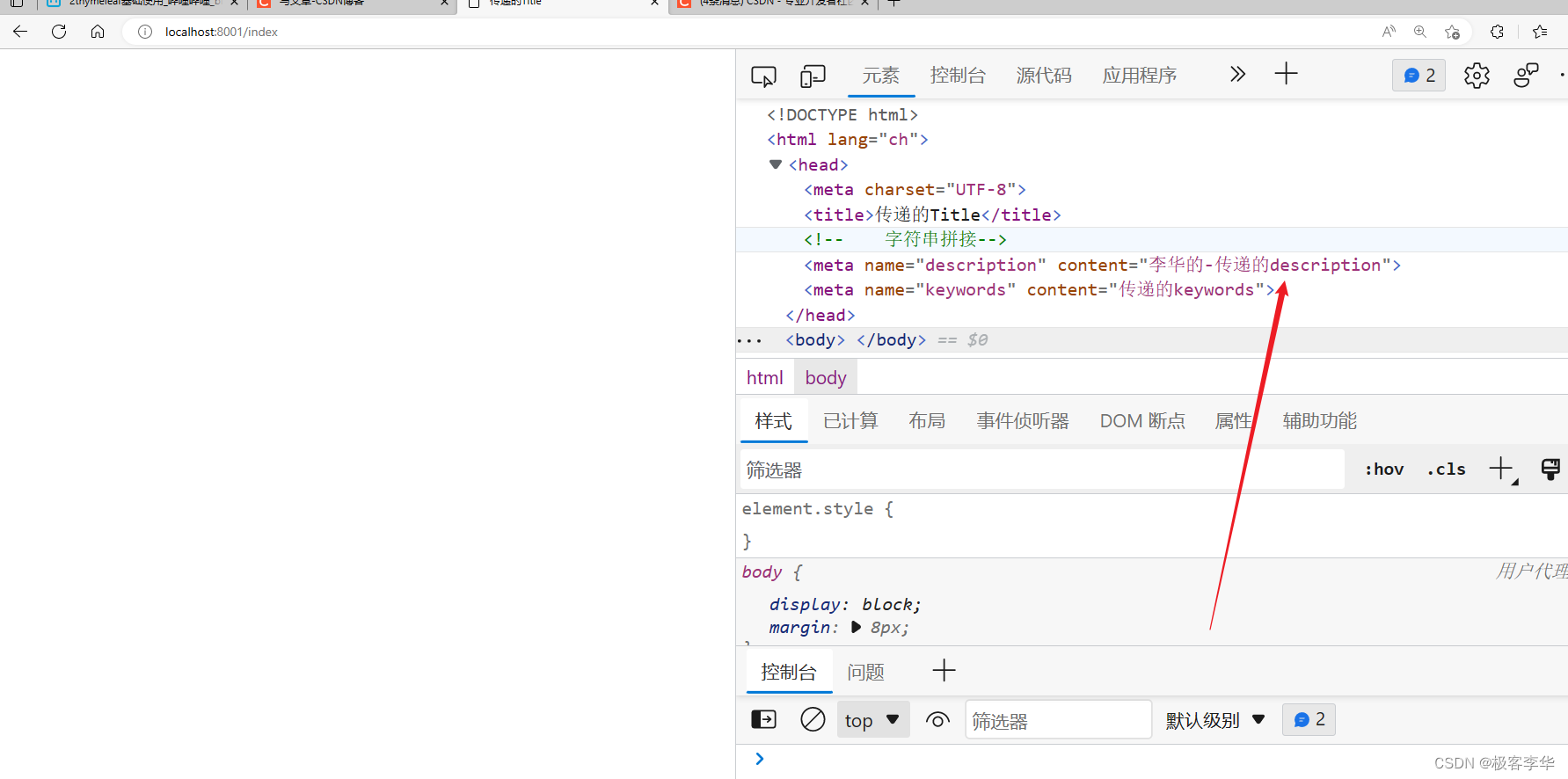
常用方法
这里会演示下面这几个的用法
- th:text
- th:if
- th:object
- th:each
- th:switch
User
package com.example.thymeleafdemo.Bean;
import lombok.Data;
import java.util.Date;
import java.util.List;
@Data
public class User {
private String username;
private String password;
private Integer sex;
private Boolean isVip;
private Date birthday;
private List<String> hobbys;
}
IndexController
package com.example.thymeleafdemo.controller;
import com.example.thymeleafdemo.Bean.User;
import org.springframework.stereotype.Controller;
import org.springframework.ui.Model;
import org.springframework.web.bind.annotation.GetMapping;
import java.util.ArrayList;
import java.util.Arrays;
import java.util.Date;
@Controller
public class IndexController {
@GetMapping("/index")
public String index(Model model){
model.addAttribute("title", "传递的Title");
model.addAttribute("description", "传递的description");
model.addAttribute("keywords", "传递的keywords");
return "index"; // 对于html文件可以不写后缀名
}
@GetMapping("/UserDemo")
public String UserDemo(Model model){
User user = new User();
user.setUsername("LIHUA");
user.setUsername("123456");
user.setSex(1);
user.setIsVip(true);
user.setBirthday(new Date());
user.setHobbys(Arrays.asList("PHP", "Java", "C++"));
model.addAttribute("user", user);
return "UserDemo";
}
}
UserDemo.html
<!doctype html>
<html lang="ch" xmlns:th="http://www.thymeleaf.org">
<!-- 第一种写法-->
<h2 th:text="${user.username}"></h2>
<p th:text="${user.password}"></p>
<p th:if="${user.isVip}">会员</p>
<!-- 第二种写法-->
<div th:object="${user}">
<h2 th:text="*{username}"></h2>
<p th:if="*{isVip}">男</p>
</div>
<!--th:each-->
<ul>
<!--注意这tag变量的命名位置-->
<li th:each="tag:${user.hobbys}" th:text="${tag}"></li>
</ul>
<!--th:switch-->
<div th:switch="${user.sex}">
<p th:case="1">男</p>
<p th:case="2">女</p>
<p th:case="*">机器人</p>
</div>
</html>
运行结果
通过运行结果可以知道,这些用法的具体效果展示。
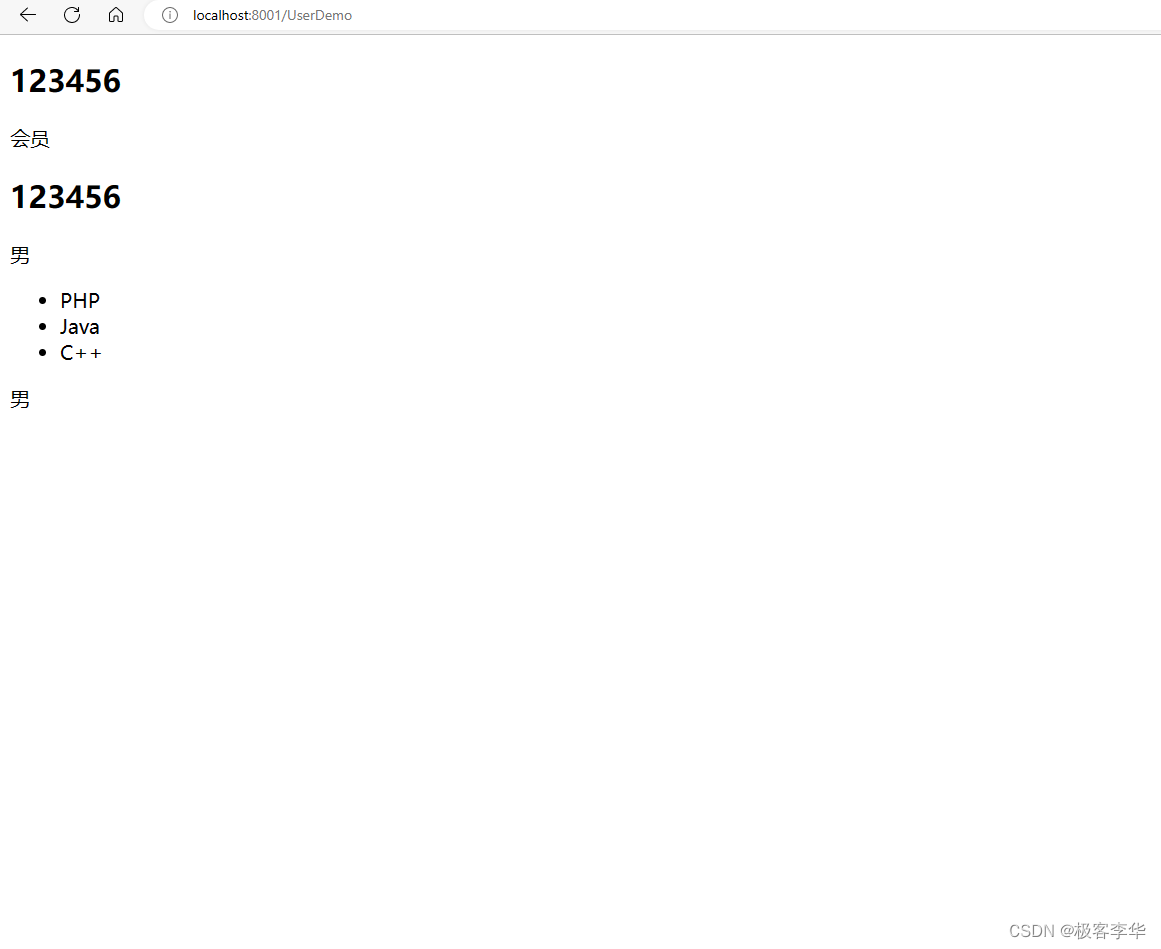
thymeleaf中js与css的使用
创建一个css文件
style.css
.box{
height: 200px;
width:200px;
background-color: pink;
}
UserDemo.html
<!doctype html>
<html lang="ch" xmlns:th="http://www.thymeleaf.org">
<link rel="stylesheet" th:href="@{style.css}">
<div class="box"></div>
<script th:inline="javascript">
// 后面的{}里面如果没有内容,就会填充注释里面的内容
const user = /*[[${user}]]*/{};
console.log(user)
</script>
</html>
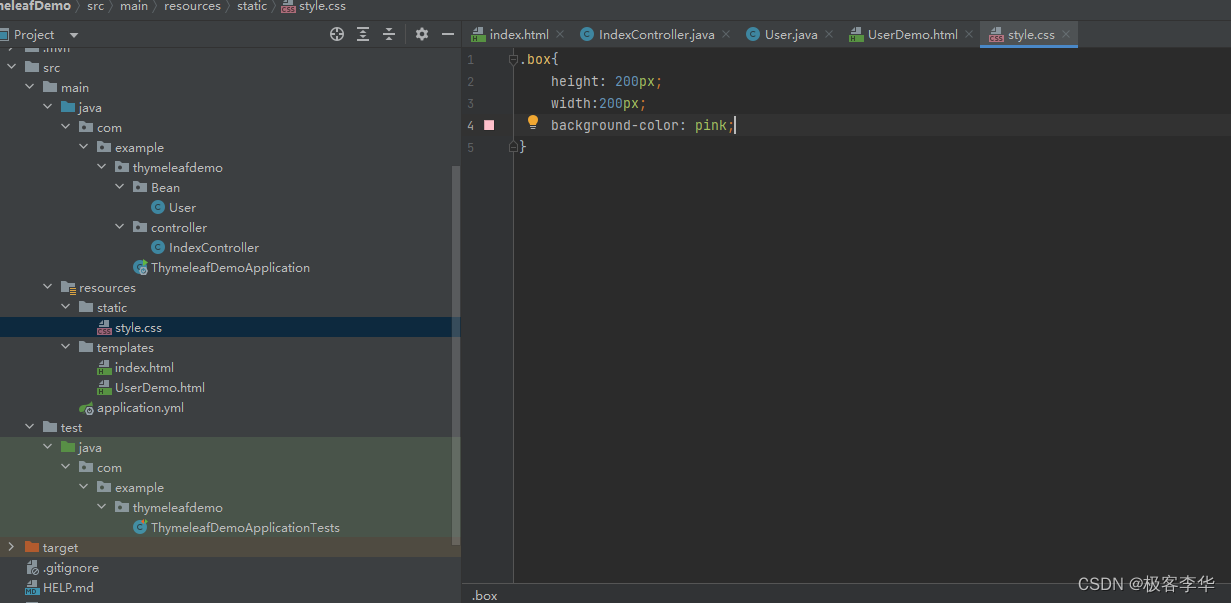

其他效果,让最后一个列表变成红色。
index.html
<!doctype html>
<html lang="ch" xmlns:th="http://www.thymeleaf.org">
<link rel="stylesheet" th:href="@{style.css}">
<style>
.active{
color:red;
}
</style>
<div class="box"></div>
<!--th:each-->
<ul>
<li th:each="tag:${user.hobbys}" th:text="${tag}"></li>
</ul>
<ul>
<!-- classappend是追加属性的意思-->
<!-- 然后这是演示如何在把最后一个元素编程active-->
<li th:each="tag, state:${user.hobbys}"
th:text="${tag}"
th:classappend="${state.last}?active"
>
</li>
</ul>
<script th:inline="javascript">
// 后面的{}里面如果没有内容,就会填充注释里面的内容
const user = /*[[${user}]]*/{};
console.log(user)
</script>
</html>

thymeleaf组件的使用
第一部分 replace insert id
这里演示了thymeleaf中组件的replace与insert的用法,还提到了另一种方式,就是用id替换fragment。
演示代码
component1.html
<!doctype html>
<html lang="ch" xmlns:th="http://www.thymeleaf.org">
<footer th:fragment="com1">
我是第一个组件
</footer>
<div id="com2">
我是第二个组件
</div>
</html>
index.html
<!doctype html>
<html lang="ch" xmlns:th="http://www.thymeleaf.org">
<head>
<meta charset="UTF-8">
<title th:text="${title}">默认的title</title>
<!-- 字符串拼接-->
<meta th:content="|李华的-${description}|" name="description" content="默认的description">
<meta th:content="${keywords}" name="keywords" content="默认的keywords">
<link rel="stylesheet" th:href="@{style.css}">
</head>
<!--这个是替换效果-->
<!--replace com1-->
<div th:replace="~{components/component1::com1}">
</div>
<!--这个是插入效果-->
<!--insert com1-->
<div th:insert="~{components/component1::com1}"></div>
<!--id形式插入-->
<div th:insert="~{components/component1::#com2}"></div>
</html>
运行结果
从结果可以看出来,第一个是采取的replace的方式,这个方式之下,是直接用组件的内容,替换原来位子的内容的,然后另一个是insert的方式,在这个方式之下,是在原来的组件的前提之下,内部插入一个组件,然后还有一个id的方式,效果和第一个差不多。
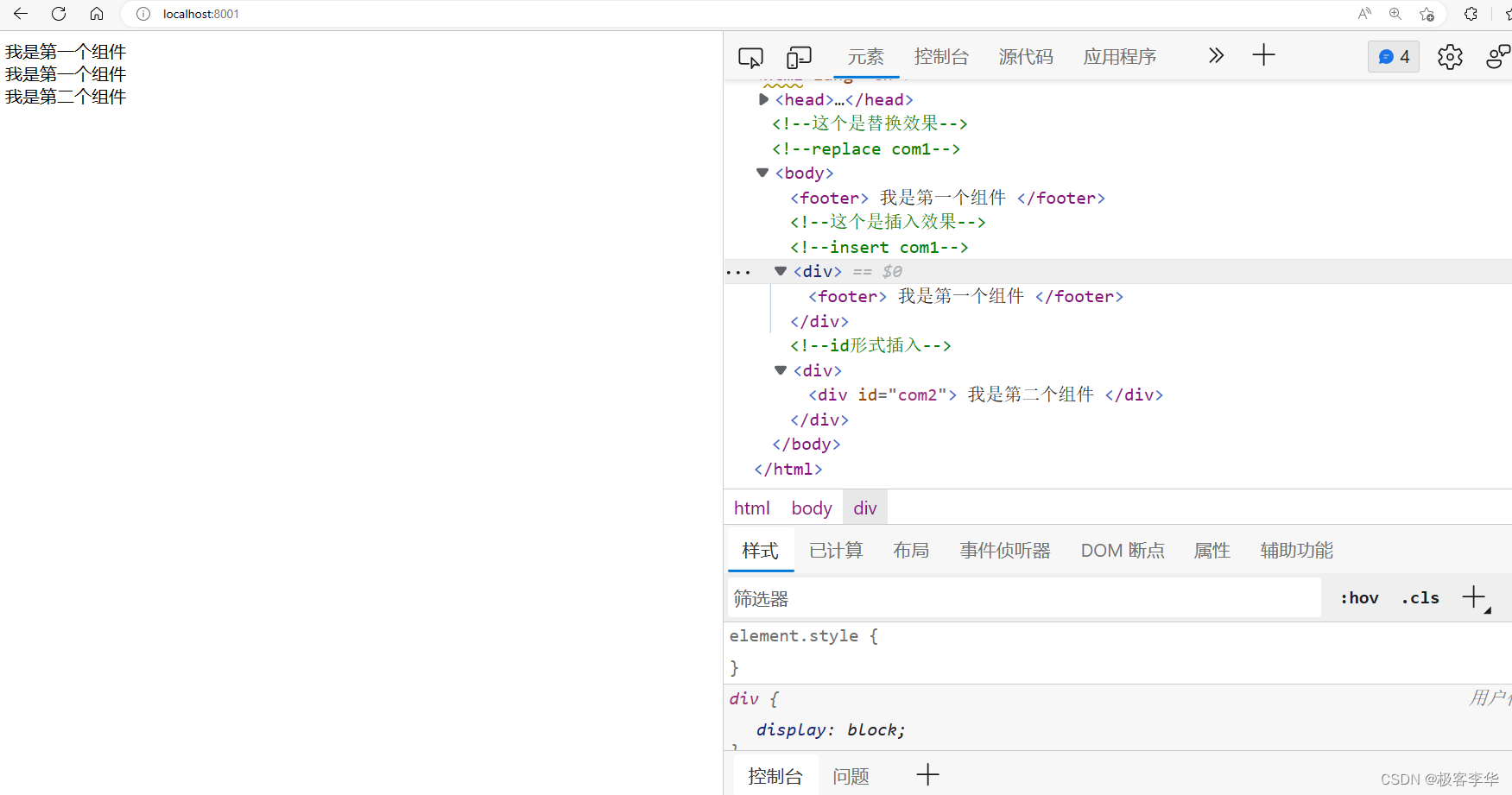
传值
第一种
组件中也可以使用原来文本中数据对象。
代码演示
component1.html
<!doctype html>
<html lang="ch" xmlns:th="http://www.thymeleaf.org">
<footer th:fragment="com1">
我是第一个组件
</footer>
<div id="com2">
我是第二个组件
</div>
<div th:fragment="com3(message)">
<p th:text="${message}"></p>
</div>
</html>
index.html
<!doctype html>
<html lang="ch" xmlns:th="http://www.thymeleaf.org">
<head>
<meta charset="UTF-8">
<title th:text="${title}">默认的title</title>
<!-- 字符串拼接-->
<meta th:content="|李华的-${description}|" name="description" content="默认的description">
<meta th:content="${keywords}" name="keywords" content="默认的keywords">
<link rel="stylesheet" th:href="@{style.css}">
</head>
<!--这个是替换效果-->
<!--replace com1-->
<div th:replace="~{components/component1::com1}">
</div>
<!--这个是插入效果-->
<!--insert com1-->
<div th:insert="~{components/component1::com1}"></div>
<!--id形式插入-->
<div th:insert="~{components/component1::#com2}"></div>
<div th:insert="~{components/component1::com3('传递过来的数据')}"></div>
</html>
运行结果
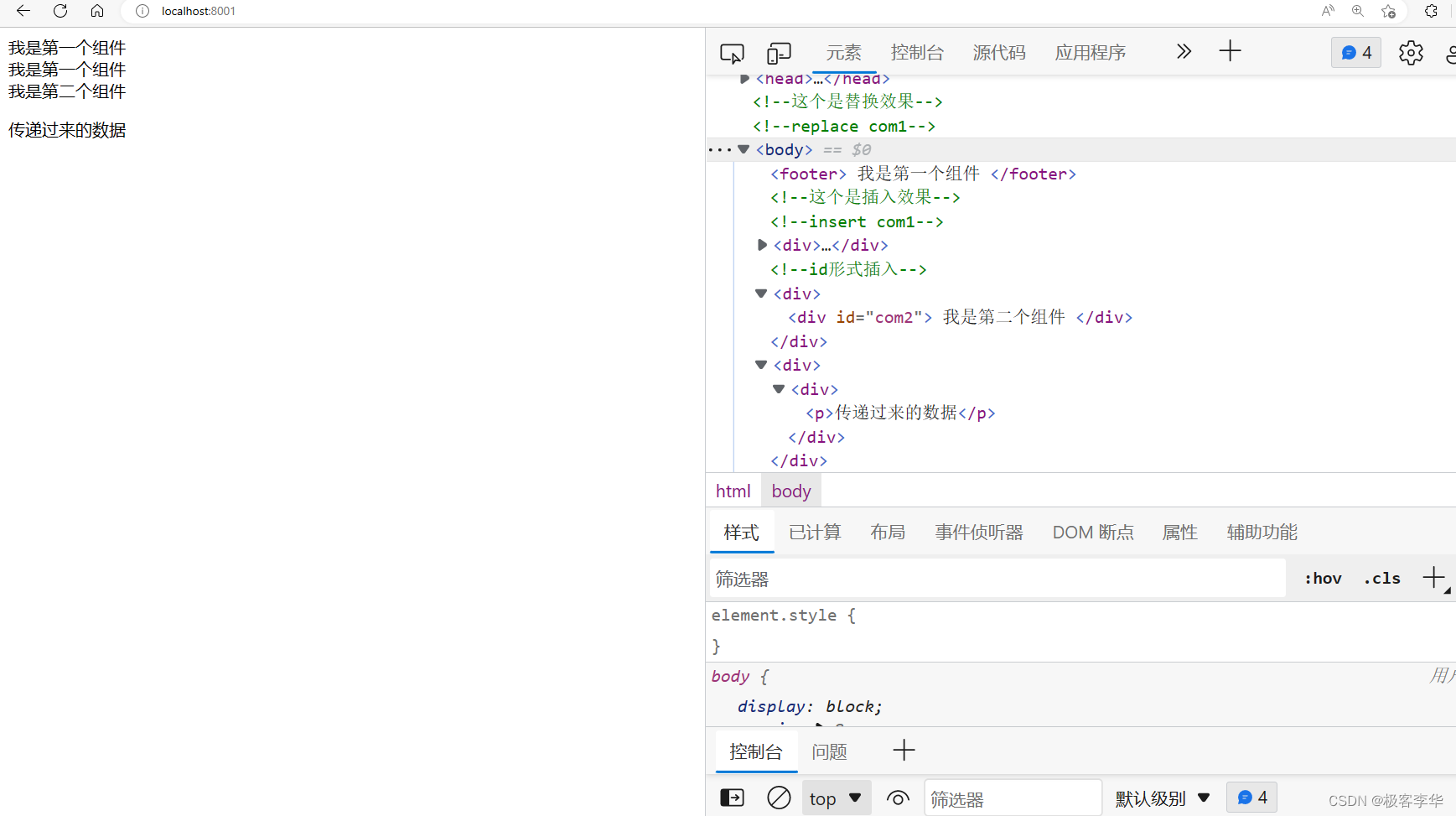
第二种
index.html
<!doctype html>
<html lang="ch" xmlns:th="http://www.thymeleaf.org">
<head>
<meta charset="UTF-8">
<title th:text="${title}">默认的title</title>
<!-- 字符串拼接-->
<meta th:content="|李华的-${description}|" name="description" content="默认的description">
<meta th:content="${keywords}" name="keywords" content="默认的keywords">
<link rel="stylesheet" th:href="@{style.css}">
</head>
<!--这个是替换效果-->
<!--replace com1-->
<div th:replace="~{components/component1::com1}">
</div>
<!--这个是插入效果-->
<!--insert com1-->
<div th:insert="~{components/component1::com1}"></div>
<!--id形式插入-->
<div th:insert="~{components/component1::#com2}"></div>
<div th:insert="~{components/component1::com3('传递过来的数据')}"></div>
<div th:insert="~{components/component1::com4(~{::#message})}">
<p id="message">替换模块</p>
</div>
</html>
component1.html
<!doctype html>
<html lang="ch" xmlns:th="http://www.thymeleaf.org">
<footer th:fragment="com1">
我是第一个组件
</footer>
<div id="com2">
我是第二个组件
</div>
<div th:fragment="com3(message)">
<p th:text="${message}"></p>
</div>
<div th:fragment="com4(message)">
<div th:replace="${message}"></div>
</div>
</html>
运行结果
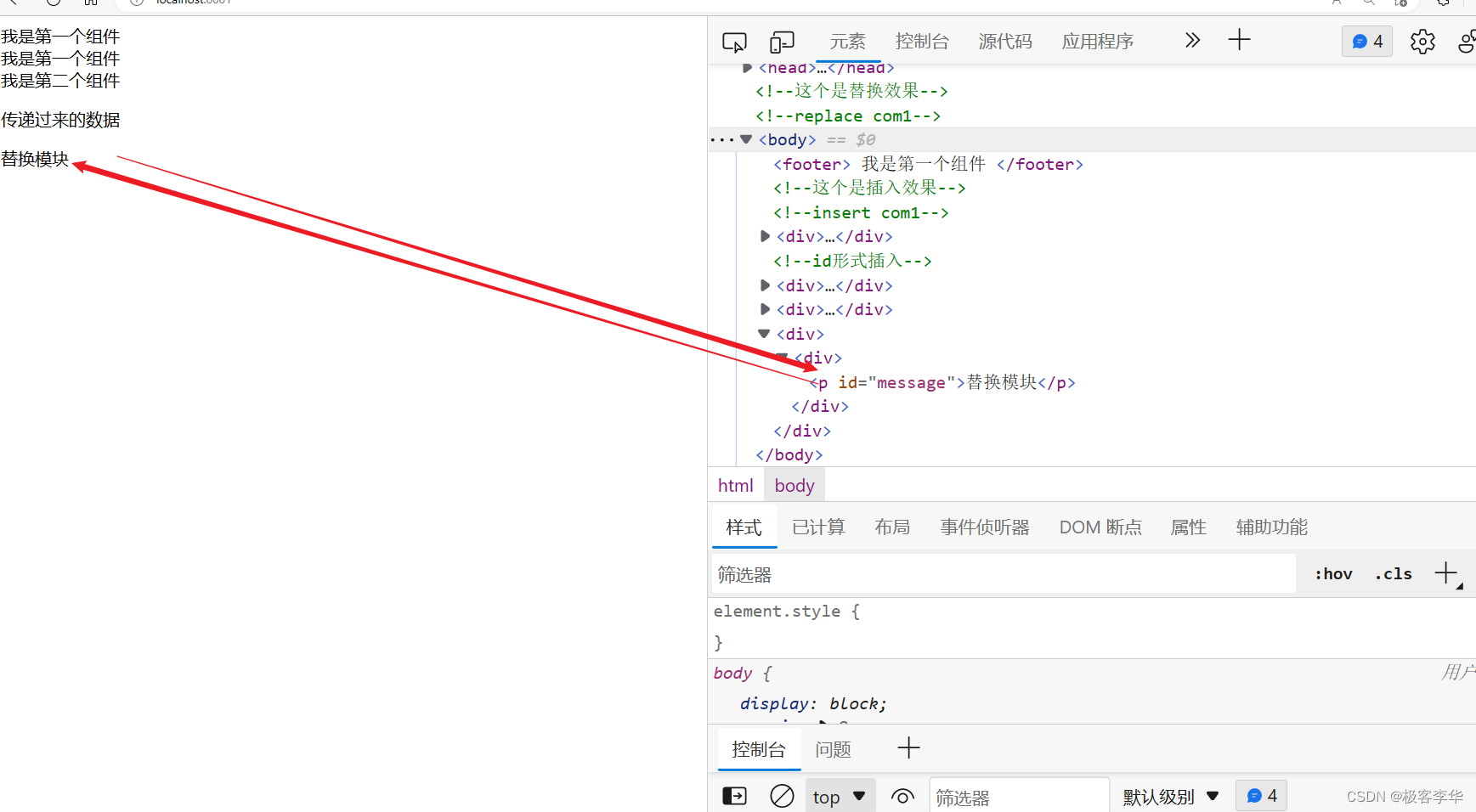
第三种
这种方式需要的是,写一行注释,不然的话会报错的
<!doctype html>
<html lang="ch" xmlns:th="http://www.thymeleaf.org">
<footer th:fragment="com1">
<!--/*@thymesVar id="user" type="com.example.thymeleafdemo.Bean.User"*/-->
<h2 th:text="${user.username}"></h2>
</footer>
<div id="com2">
我是第二个组件
</div>
<div th:fragment="com3(message)">
<p th:text="${message}"></p>
</div>
<div th:fragment="com4(message)">
<div th:replace="${message}"></div>
</div>
</html>






















 1780
1780











 被折叠的 条评论
为什么被折叠?
被折叠的 条评论
为什么被折叠?










